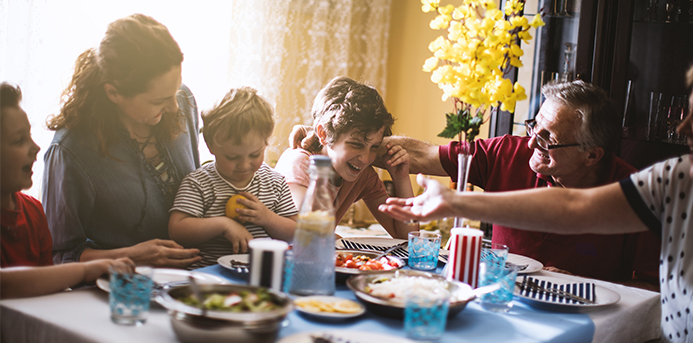What if there was a single activity you could do at home, requiring no special equipment or cost of any kind, that would have lifelong benefits for the physical, emotional, academic and social health of every member of your family? And what if that activity was available to just about every household — but fewer than half of them chose to engage in it regularly?
That activity exists, and it’s the family dinner.
Decades of research, like this Cornell University report, have shown that more than any other single activity, regular family dinners have the capacity to provide a host of important benefits, including:
- Healthier eating habits
- Decreased consumption of sodas, fried foods and trans fats
- Increased vocabulary and literacy skills in children
- Better grades and improved peer relationships at school
- Higher satisfaction in parents’ relationships
- Decreased risk behaviors in teens, such as alcohol and drug use, eating disorders and teen pregnancy
- Lower incidence of depression and anxiety in both children and adults
Intriguingly, the single most common developmental denominator cited by Fortune 500 CEOs is that they grew up regularly eating family dinners. Athletic achievements, Eagle Scout badges and Ivy League educations were distant runner ups in comparison.
Tragically — despite the compelling research — fewer families regularly eat together now than ever before. Recent studies show that by high school, only about 20 percent of kids report eating with their families at least once a day. Obstacles cited include scheduling and time challenges, picky eating habits, lack of cooking skills and tension or lack of connectedness at the table.
There is good news though. These issues easily are remedied the the help of The Family Dinner Project, operating at Project Zero at Harvard Graduate School of Education. This nonprofit’s mission is to enrich families’ lives through food, fun and conversation about things that matter. Their online resources and community events help families benefit from eating together.
Supported by stories from real families, five of The Family Dinner Project’s top tips include:
1. Get Creative with Connections.
Between work obligations, sports practices, homework and extracurricular activities, there are countless reasons why it may feel next to impossible to get everyone together around the table. But you can still reap the benefits of connecting at the table, even when you can’t all physically gather. Active-duty military members in Blue Star Families — many of whom have faced the ultimate “scheduling challenge” through military deployments — have shared their tips for having “family dinners” during periods of difficult scheduling:
- Write a “conversation by sentence” that can be shared with absent family members at another time; they can add their own responses and send it back to be shared at the table.
- Use Skype or FaceTime to give a “face-to-face” experience at the table, even if a family member is unable to be present for the meal.
- Take advantage of dessert, late-night snacks and early breakfasts with busy loved ones to cultivate a shared meal habit even when you can’t have a full meal together.
Finding creative ways to share a meal despite challenges pays off in the long term. As one military spouse says, “It hasn’t always been easy for my husband to find time to fit family dinner into his busy military schedule. But after we went to The Family Dinner Project Community Dinner, instead of eating quickly and leaving the table, he makes an effort to sit and talk with us over dinner.”
2. Focus on Family, Not Food.
Despite the dismal statistics, research has shown that the majority of teens enjoy eating dinner with their families and would want to do so more often. “Family dinner should be a priority, not a privilege,” says Gabriela Townsend, a teen leader and member of FCCLA. Try these tips to help keep dinner on the schedule even when you don’t have a lot of time to cook:
- Take advantage of healthful convenience foods like rotisserie chickens, pre-chopped vegetables and frozen produce to make a meal in minutes.
- Keep it simple! Sandwiches and fruit, eggs or a big salad with your choice of protein are all great low-cook dinner options — and many kids and teens may be able to help prepare these choices.
- Don’t stress about the food. Focus on having fun and talking to one another at the table, regardless of what you’re eating.
Another FCCLA teen, Makayla Hendricks, says that both parents and kids should put forth the effort, even when it’s difficult. “I notice a huge difference in my relationship with my mom when we focus on eating dinner together. It can be hard but I promise if you put forth the effort and help prepare and clean up your meals that your relationships with your family members will strengthen.”
3. Cultivate Conversation.
“How was your day?” “Fine.” “What did you do?” “Nothing.” Rather than asking the same old questions, introducing broader topics can draw out a more enriching conversation. For example, you might not think to ask your kids about giving and community service, but Henry Timms of the 92Y (and co-founder of #GivingTuesday) says, “Talking about philanthropy with children couldn’t be more important. I don’t think you can measure that kind of thing now, but you’ll be able to measure it in 20 years’ time.” The same is true of any dinner table conversation; what you talk about tonight can shape how your family thinks, feels and acts far into the future.
- Keep conversation starters handy to help break the ice as needed — The Family Dinner Project has hundreds on their site, ranging from philosophical to funny, and tailored for specific age groups. For example, you might ask, “If you could have any superpower, what would it be and how might you use it to help others?”
- Try playing a game at the table to help family members engage. Whether it’s a game of Two Truths and a Lie, or bringing trivia questions or favorite card games to the dinner table, having an activity to focus on can relieve some of the pressure and get conversations flowing naturally.
- If one-word answers persist, try some of these expert tips on opening up the lines of communication and getting past “Fine.”
4. Tame the Technology.
Common Sense Media has discovered that 51 percent of adults feel that using devices at the dinner table worsens the quality of their family relationships, yet families often don’t know how to curb technology at mealtime.
The good news is that tech at the table doesn’t have to be all-or-nothing. While making the table a screen-free zone can work well, all families can find their own balance using some of the following tips:
- Consider using technology only to enhance conversations — such as the Blue Star Families’ tip about connecting with absent loved ones during dinner via Skype.
- Try putting family members’ phones in the middle of the table. First one to reach for a screen does the dishes!
- Allow each family member one “tech share” during the meal, so that funny cat video, a classmate’s message or an interesting article can spark conversation.
5. Monitor the Mood.

While it’s important to keep family dinner as welcoming and enjoyable as possible, occasional tension at the table can be a good opportunity to teach the art of respectful disagreement. “It’s important to model and be mindful of what you’re modeling. It doesn’t mean you never fight. In fact, it can be helpful to model how you work things out,” says Richard Weissbourd, psychologist, author and co-director of the Making Caring Common Project.
Dr. Anne Fishel, Ph.D., family therapist, author and co-founder of The Family Dinner project, recommends many strategies to help families keep tension at a minimum, among them:
- Keep controversial topics — like grades, curfews and behavior problems — off the table and set another, non-dinner time to discuss them.
- Go easy on nitpicking manners; focus on family connections, not whose elbows are on the table.
- Use music as a way to keep the mood fun and relaxed, before, during and after dinner.
The Family Dinner Project developed as a collaboration between Fishel, famed Harvard psychologist Howard Gardner, PhD, and retired AT&T Executive Shelley London, as a result of London’s participation in Harvard’s Advanced Leadership Initiative. You can watch The Family Dinner Project in action and a Fishel interview with CNN here:
The Family Dinner Project also participated in this year’s On The Table by the Chicago Community Trust.
Family dinners offer tangible, lifelong benefits that can be enjoyed by everyone, as long as they gather around the table together. The memories and connections your children make around your family dinner table will last longer than those from potential competing activities. More importantly, though, those dinners are one of your most powerful tools to help nurture your children into healthy, successful adults.
Become a part of this national movement toward food, fun and conversation about things that matter by connecting with The Family Dinner Project and bringing some of their resources to your own dinner table tonight. Or, help The Family Dinner Project to help other families by connecting with or donating to:
The Family Dinner Project
13 Appian Way, 4th Floor
Cambridge, MA 02138
T: 929-244-0406
More from Make It Better:
- Founder’s Letter: Your Dinner Table is Your Power Table
- 8 Lunch Box Goodies That Your Child Won’t Trade Away
- 6 Tips for Healthy Grilling

Susan B. Noyes is the founder of Make It Better. She practiced labor law at Sidley & Austin before deciding to lay down the law full-time for her six children instead. Her favorite time of the day is family dinner, despite her children’s constant misbehavior. Susan loves to network, build community, write and organize lots of moving pieces. Her motto: “A clean home is a wasted life.”

